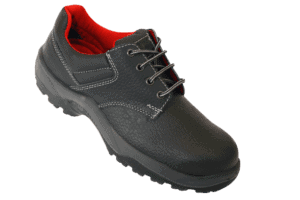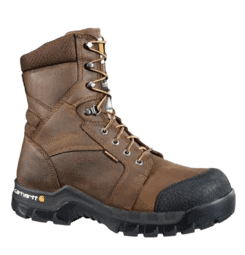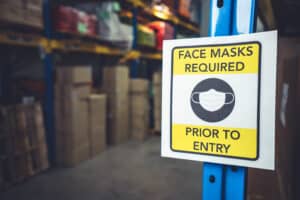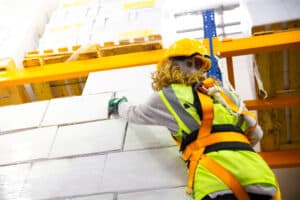Personal protective equipment protects warehouse workers from work related injury. Some PPE is compulsory for all warehouse workers (e.g. steel-toe boots) while other types depend on the specific warehouse job (e.g. hard hats and safety glasses for maintenance crews).
To reduce risks and increase safety for everyone involved, it is important that all employees know how to identify hazards in their work environment and protect themselves with the appropriate PPE.
In this article, we will explore some common PPE that warehouse workers need to have to help mitigate these dangers and work safely.
Steel-toe Shoes and Boots
Steel toe shoes/boots are mandatory in almost all warehouses and distribution centers. They protect your feet from falling objects such as pallets and boxes as well as being rolled over by equipment like forklifts.


Since warehouses are fast and busy environments, lighter safety shoes are recommended. They help reduce fatigue for workers who are on their feet for long periods of time and walk tens of miles per day on the floor.
Lighter steel-toe shoes and boots also help reduce injury, particularly to the ankles and Achilles tendon.
For freezer warehouse workers, insulated steel-toe boots are recommended. These boots should also be waterproof as cold storage/warehouses tend to develop high humidity from time to time.
Another quality for good freezer boots is sufficient slip resistance due to the many times the floors get wet and subsequently form ice as the water freezes and gets slippery.
Gloves

For warehouse workers whose job includes material handling, gloves are necessary to protect hands from scratches.
Boxes, pallets, equipment, mesh bags and other object can quickly cause bruises and other kinds of injuries to your hands if you’re not wearing gloves.
The best gloves for warehouse workers are those that prioritize good grip and comfort.
For those working in warehouse freezers, warmth and water resistance are good additional qualities to prevent your hands from freezing.
Headwear
Depending on the conditions and/or rules of the warehouse, headwear may be a necessity for some warehouses and distribution centers.
Baseball hats and beanies help protect one’s head from the cold and dust.
Balaclava and Gaiter
Balaclavas and gaiters are useful for those working in cold warehouse environments. They keep your face warm while not restricting air flow to your nostrils. The CDC also gives special consideration to gaiters as a replacement for face masks as long as they have two layers or are folded to make two layers.
Hard hats
Hard hats are not required in most warehouses except for a few special instances. For example workers on picker forklifts or when there is an ongoing construction, maintenance or repair of the roof, the personnel involved with that task might need to wear hard hats as part of fall protection measures.
Face Masks
Face masks are now a familiar facial feature on many warehouse floors. Social distancing and covering up your mouth and nose is now the norm as we try to minimize the risk of exposure to infections.

Warehouse management now needs to set rules that make it mandatory to wear masks when inside the facility – at least until the risk of being infected with the Corona virus is minimized. These rules and policies should be continuously emphasized and audited to ensure everybody abides by them for the good of the whole team.
Supervisors and security personnel should be empowered to keep a vigilant eye on guests and workers inside the building to ensure everyone is wearing their masks correctly. The management team may also set up caution signs around the warehouse facility to remind workers and visitors that masks are required.
To make it easier for workers, warehouse management should make these masks readily available from dispensers. These dispensers should be strategically placed in entrances and exits to ensure both visitors and workers are not interrupted by lack of masks while trying to access the building.
Face Masks and Foggy Glasses
Depending on the warehouse or distribution center, there may be elevated humidity levels. This can be a nuisance for eyeglass and safety glasses wearers as when breathing out, the humid air escapes through the top of the mask and fogs up the glasses. This limits visibility and can be dangerous especially for workers who drive heavy equipment such as reach trucks.
Anti-fog sprays and wipes are a good solution for this problem and should be made readily available to employees who need them.
Face Shields
According to the CDC, face shields are not effective at protecting people from respiratory droplets due to the large gap below and on the sides of the mask that allows the droplets to escape.
Hearing Protection
Constant droning noise is a major issue in some warehouses.
Warehouse jobs that require one to stand in place close to loud machinery over extended periods of time are especially prone to causing ear damage.
OSHA regulations set a maximum of 90 decibels of sound exposure over an eight hour work day.
Sound Level Meter
Sound level meters are the best way to assess sound levels in a standardized way.
Use a sound meter to determine whether you need to take corrective action to protect hearing in a warehouse.
Earplugs and Ear Muffs
Earplugs and ear muffs are a good solution to this problem. Earplugs generally have a higher noise reduction rating (NRR) than ear muffs. Some people prefer to wear both at the same time.
Earplugs have the benefit of being lightweight and cheap compared to earmuffs.
Earplug Selection
Ear plugs come in different material, sizes and shapes. The biggest brands in this space are 3M and Howard Leight.
Size

Ear canals vary in size so you will find ear plugs with different diameters. It’s important to choose one that will fit comfortably in your ear while at the same time not sliding out.
With the soft foam ear plug, you don’t need to know the size of your ear canal. You just need to roll it with your fingers to make it thin, pull your ear back and then insert it into the canal.
You then hold it in with your finger until it expands and makes a good seal. You’ll know it fit correctly if the noise around you gets muffled.
Shape
Some earplugs are rod shaped, some have tapered tips that makes insertion easier while others have outer contours for better grip.
Material
Earplugs may be made of silicone, cotton, plastic, PVC or polymer. Silicone is by far one of the most comfortable earplug material because it is very flexible and smooth.
Single Use Vs Reusable Earplugs
Reusable earplugs are more expensive in terms of purchase cost but tend to be cheaper over time. They are even better if they are corded, which protects them from loss since they can be hung around the neck.
Single use earplugs are suitable for workplaces like warehouses where they can be conveniently served from a dispenser.
Earplugs made specifically for noisy work environments such as the 3M 1100 Foam plugs are very affordable when bought in bulk and can be used as refill for dispensers.
Ear Muffs

Good quality ear muffs should be snug, comfortable and fit well.
Workers wearing hard hats should go with cap-mounted ear muffs such as the 3M Peltor Ear Muffs.
Ear muffs with electronic hearing protection make it easier for you to hear people speaking while still in active use.
High Visibility Clothing and Overalls
Hi-vis vests are not just for construction workers. They are necessary for warehouse workers whose job involves walking or driving equipment on the floor such as pickers, forklift drivers, lumpers, etc. In most cases reflective jackets or vests are sufficient for visibility to oncoming traffic of reach trucks, forklifts, pallet jacks and ride-on scrubbers.
Safety Glasses
For day-to-day work in most warehouses, safety glasses are not necessary. For the maintenance workers and technicians, they may be mandatory especially when welding, metal grinding or dealing with chemicals. With these types of jobs, the warehouse management should provide employees with suitable eye protection.
Hand Sanitizer
Due to the ongoing pandemic, there is increased awareness about the importance of disinfecting our hands and the equipment we use at the warehouse. It is good practice to always clean your hands and equipment before and after starting work.
Liquid hand sanitizers and wipes help in minimizing the risk of exposure to infections. They are a cheap and useful tools for warehouses to protect their workers’ health.
According to the CDC, hand sanitizers are not as effective as using soap and water as they do not eliminate all types of germs. They are also not as effective when used on visibly dirty hands.
However, disinfecting wet wipes and liquid dispensers are some of the best options fast moving warehouses can offer to their busy staff. It is therefore important for warehouse management to set them up in easily accessible locations such as doorways, break rooms, kitchens, bathrooms and other high traffic areas.
Fall Protection
OSHA mandates that organizations should provide fall protection starting at the height of four feet.

Some warehouse jobs such as forklift picker or cherry picker operator require harnesses to protect workers from falls. These harnesses are typically attached to a lanyard, which itself is attached to the machine the worker is using, e.g. a picker forklift.
It is recommended that workers inspect their harnesses for effectiveness as part of the safety check before they start working. The lanyard should not have excessive wear and tear, otherwise it could pose a huge risk of snapping.
Management should ensure that unsafe harnesses are replaced immediately and that they are not used in the warehouse.
Bulk PPE Suppliers
The following is a list of some of the largest bulk suppliers of PPE equipment on the Internet.
| Company | Products | Link |
| Staples | Hi-vis vets, jackets and harnesses, hand sanitsers, wipes and dispensers, earplugs | staples.com |
| Well Before | Hand sanitizer, disinfectant wipes, face shields, 3 ply face masks | https://wellbefore.com/ |
| Cat Footwear | Steel toe shoes and boots | https://www.catfootwear.com/US/en/home |
| Working Person’s Store | Steel boots and shoes, hi-vis clothing, gloves, overalls, headwear | https://workingperson.com/ |
| Bulk Office Supply | Safety eyewear, face masks | https://www.bulkofficesupply.com/ |
Conclusion
The Occupational Safety and Health Administration (OSHA) provides a list of policies that should be followed to protect warehouse workers. These include providing the necessary PPE, training employees on how to use it correctly, and enforcing safety rules for all personnel in the workplace. All these measures are important for ensuring worker safety during their time at work as well as after they leave work each day. Warehousing managers can help by encouraging compliance with OSHA regulations.